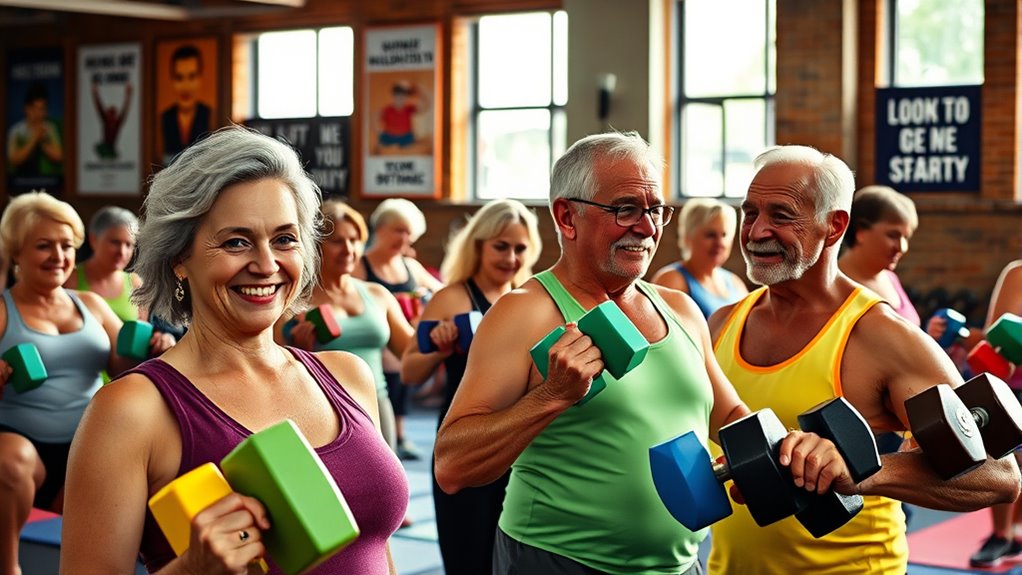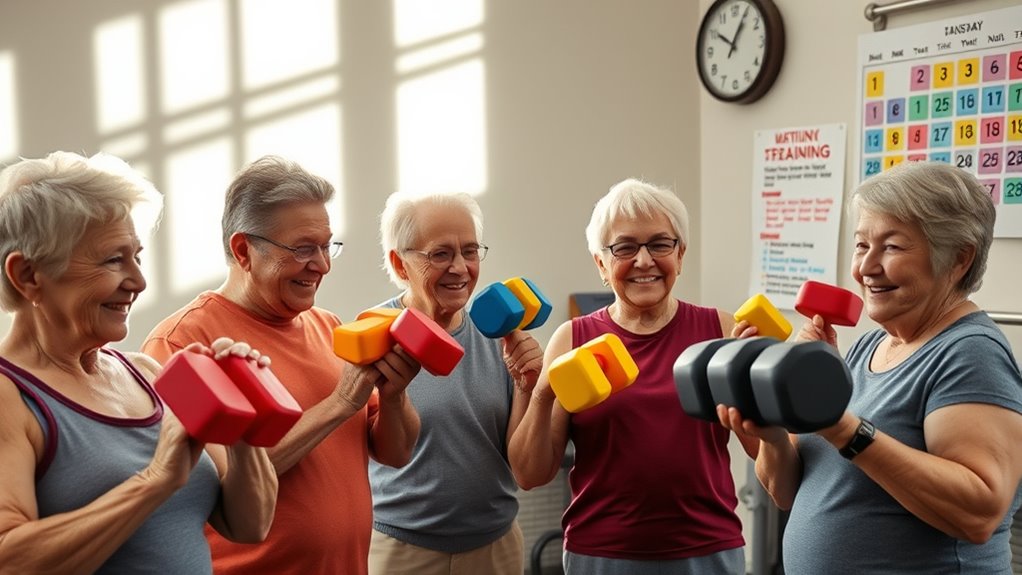Weight training can truly transform your life as a senior. It boosts your physical health, improves balance, and enhances mental well-being. You’ll maintain muscle mass and prevent falls, while also elevating your mood and boosting cognitive function. Starting with bodyweight exercises is a great way to build strength safely, and progressing to light weights can further increase your benefits. Discover how to create an effective workout schedule and stay motivated on your fitness journey ahead.
Key Takeaways
- Strength training combats age-related muscle loss, enhancing physical health and overall well-being for seniors.
- Improved balance and mobility from strength training significantly reduces fall risk and enhances quality of life.
- Regular weight training boosts bone density, helping prevent osteoporosis and fractures in older adults.
- Incorporating bodyweight exercises safely builds strength, making fitness accessible for all seniors, regardless of their fitness levels.
- Essential exercises like squats, pushups, and seated rows can transform seniors’ strength and stability, promoting long-term health benefits.
The Importance of Strength Training for Seniors

As you age, maintaining your strength becomes increasingly important, not just for physical health but for overall well-being.
Strength training is essential for older adults, as it combats age-related muscle loss, or sarcopenia, which causes muscle mass to decline annually. By incorporating resistance training into your routine, you can improve balance and reduce the risk of falls, enhancing your mobility and independence.
Strength training is vital for older adults to combat muscle loss, enhance balance, and maintain mobility and independence.
Additionally, strength training boosts bone density, helping to prevent osteoporosis and fractures. It also supports metabolic health by regulating blood sugar levels, aiding in diabetes management.
Beyond physical benefits, engaging in strength training positively impacts mental health, reducing symptoms of depression and anxiety while improving mood and cognitive function. Furthermore, incorporating protein-rich meals into your diet can further enhance your strength training results.
Embrace strength training for a healthier, more fulfilling life.
Key Benefits of Weight Training in Later Life

Weight training offers you essential benefits as you age, helping maintain muscle mass and enhance bone health. It also plays a significant role in improving your mental well-being, promoting a positive mood and cognitive function. Additionally, environmental interactions can further support your physical and emotional growth through consistent exercise routines. Incorporating self-care routines into your weight training regimen can help replenish energy levels and boost overall resilience. Engaging in regular strength training can also lead to improved cognitive performance, contributing to better mental clarity and focus as you age. Furthermore, regular physical activity is crucial for overall health, as it can significantly reduce the risk of chronic diseases. Moreover, maintaining high vibrational energy during workouts can enhance your overall experience and effectiveness in strength training.
Muscle Mass Maintenance
Maintaining muscle mass becomes increasingly important as you age, especially since it starts to decline by 1-2% annually after age 50. Weight training plays a crucial role in combating sarcopenia, helping older adults improve muscle strength and overall functional abilities. Regular resistance training enhances quality of life by promoting balance and stability, which reduces the risk of falls. Engaging in physical activities, such as weight training, can lead to a healthier and more active lifestyle, while supporting gut microbiota which is essential for overall digestive health. Additionally, incorporating digital literacy programs can further empower seniors to engage with their health and fitness goals through technology. Research indicates that young players who start training early often see long-term benefits, illustrating the importance of early engagement in physical activities. Furthermore, early socialization and training can significantly enhance physical and mental wellness, ensuring a well-rounded approach to senior fitness.
| Benefits of Weight Training | Impact on Older Adults |
|---|---|
| Increases Muscle Mass | Enhances Daily Activity |
| Improves Physical Strength | Reduces Mortality Risk |
| Boosts Quality of Life | Increases Balance & Stability |
| Fights Sarcopenia | Supports Longevity |
With consistent strength training, you can gain strength—even at age 80 and beyond!
Enhanced Bone Health
While you may not realize it, engaging in weight training can greatly enhance your bone health as you age. This form of resistance training places stress on your bones, stimulating growth and increasing bone density—crucial for preventing osteoporosis and reducing fracture risk in seniors. Additionally, incorporating indexed annuities into your financial planning can provide a safety net that helps manage healthcare costs associated with aging. Understanding the importance of clear communication during any transitions can also contribute to emotional well-being.
Regular weight training can lead to a 1-3% increase in bone mineral density over time. It also strengthens the muscles surrounding your joints, promoting better joint stability and flexibility, which are essential for maintaining mobility. Additionally, participating in outdoor activities like hiking or camping can further contribute to overall fitness and well-being. Moreover, incorporating a 30-40% energy savings strategy through consistent exercise can help reduce overall health costs associated with aging.
Additionally, seniors who lift weights experience significant fall prevention benefits, as improved bone health contributes to better balance and coordination. In fact, research shows a 20-30% reduction in fracture risk for those who incorporate weight training into their routine. Furthermore, integrating state-specific benefits from local retirement planning resources can further support long-term health and wellness.
Improved Mental Well-being
Engaging in weight training not only strengthens your body but also greatly boosts your mental well-being. As an older adult, you’ll find that strength training releases endorphins, lifting your mood and alleviating anxiety and depression. Improved self-esteem comes naturally as you gain muscle mass and physical capability. Additionally, incorporating ergonomic furniture in your workout space can enhance comfort and motivation. Regular physical activity is crucial for maintaining overall health, especially as we age, as it aligns with the principle of continuous learning to improve both physical and mental health. Studies indicate that personalized learning approaches can also enhance the effectiveness of fitness programs tailored for seniors.
| Key Benefits | Impact on Mental Well-being | Resulting Improvements |
|---|---|---|
| Enhanced Cognitive Function | Delays neurological conditions | Sharper thinking and memory |
| Better Sleep Quality | Restful nights | Increased energy levels |
| Increased Resilience | Greater coping ability | Confidence in daily challenges |
Regular physical activity, like weight training, also contributes to resilience, helping you to face life’s hurdles with a renewed spirit. Additionally, maintaining proper nutrition alongside your training can further enhance cognitive function and emotional well-being.
Getting Started: Bodyweight Exercises for Beginners

Getting started with bodyweight exercises is a fantastic way to build strength safely and effectively. You can focus on key movements like squats, pushups, and lunges that can easily be modified to fit your fitness level. As you gain confidence and strength, you’ll be ready to progress to more challenging workouts, including weights. Incorporating hands-on learning can enhance your exercise experience and promote overall wellness. Regular exercise, especially for seniors, can help prevent obesity and related health issues by maintaining a healthy weight. Creating living spaces that enhance quality of life can also significantly support your fitness journey by ensuring a safe and comfortable environment.
Benefits of Bodyweight Training
Starting with bodyweight training offers a fantastic way to build strength and confidence, especially for seniors. Bodyweight exercises focus on proper form, helping you lay a solid foundation before moving on to weights.
Aim for three sets of 10 to 15 repetitions to effectively develop muscle strength and endurance. This approach minimizes the risk of injuries, making it a safe option for older adults. Plus, modifications, like using a chair for squats, keep these exercises accessible for varying fitness levels.
As you progress, gradually increasing the intensity of your workouts prepares you for a smooth shift to resistance training. Embracing bodyweight exercises not only boosts your physical capabilities but also enhances your overall confidence in staying active.
Key Bodyweight Exercises
To build a solid foundation in strength training, incorporating key bodyweight exercises into your routine is essential.
These exercises are perfect for beginners learning proper form while helping you build strength. Aim for three sets of 10 to 15 repetitions to establish a solid base and prevent injuries.
Here are four effective bodyweight exercises to get you started:
- Squats – Target your legs and improve mobility.
- Pushups – Strengthen your chest, arms, and core stability.
- Lunges – Enhance your balance and functional fitness.
- Glute Bridges – Activate your glutes and support lower back strength.
Incorporating these exercises into your regular fitness routine two to three times per week will greatly enhance your overall mobility, strength, and stability.
Progressing to Weights
As you build confidence and strength through bodyweight exercises, moving to weights can enhance your fitness routine and further challenge your muscles.
Start by gradually progressing to light weights, using the lightest dumbbells available. Aim for three sets of 10 to 15 repetitions, ensuring you maintain proper form to prevent injuries.
Resistance bands are another excellent option, offering varied resistance levels that cater to different fitness levels. This flexibility helps seniors ease into a weighted routine comfortably.
Consulting a personal trainer can be beneficial, providing guidance on form and helping you safely shift to weighted workouts.
With patience and consistent effort, you’ll not only increase muscle mass but also boost your overall confidence in your fitness journey.
Progressing to Light Weights Safely

When beginning your strength training journey, it’s crucial to start with the lightest dumbbells available, allowing you to build strength gradually while minimizing the risk of injury.
To progress safely, consider these steps:
- Maintain Proper Form: Always prioritize technique over heavy weights to prevent injuries.
- Increase Weights Incrementally: As you feel stronger, gradually increase weights to continue challenging your muscles.
- Incorporate Resistance Bands: These offer adjustable resistance, catering to your individual fitness needs and enhancing variety.
- Seek Guidance: A personal trainer can help guarantee safety and provide tailored advice on your progress and form.
Essential Strength Exercises for Older Adults

Strength exercises are crucial for older adults, not only to build muscle but also to enhance overall mobility and independence. Incorporating squats into your routine can strengthen your lower body, and you can modify them using a chair for added support.
Incline pushups are great for building upper body strength, allowing you to start at a higher incline and progress as you get stronger. Seated rows effectively target major muscle groups in your back, using resistance bands or machines for stability.
Stationary lunges also contribute to lower body strength. Finally, dead bugs engage your core strength, improving stability and balance.
These functional movements are essential for maintaining your daily activities and overall quality of life.
How to Schedule Your Strength Training Sessions

To effectively schedule your strength training sessions, aim for consistency while allowing your body time to recover. Here’s how to structure your routine for ideal results:
- Frequency: Train at least twice a week, ensuring non-consecutive days for recovery time.
- Session Duration: Start with 10 to 15 minutes, gradually increasing as your fitness levels improve.
- Muscle Groups: Target different muscle groups, focusing on both upper and lower body exercises like squats and pushups for balanced development.
- Listen to Your Body: Allow ample recovery time, as muscle soreness may take longer to heal with age, helping to prevent injuries.
Activating Your FREE SilverSneakers Account

Activating your FREE SilverSneakers account is a simple process that opens the door to a wealth of fitness resources tailored for seniors.
With access to hundreds of on-demand workout videos, including strength training using free weights and body weight, you can choose workouts that fit your fitness level. These resources promote healthy aging by enhancing joint health, improving posture, and boosting balance and coordination.
You can also join live online classes led by specially trained instructors, ensuring you receive expert guidance every step of the way. Plus, SilverSneakers connects you to thousands of gyms nationwide, fostering community involvement and providing opportunities for in-person workouts.
Just verify your eligibility through your Medicare Advantage plan, and you’re ready to start!
Staying Motivated and Committed to Your Fitness Journey

With your SilverSneakers account activated, you’re now equipped with the resources to kickstart your fitness journey. Staying motivated and committed involves several key strategies:
- Set realistic goals to boost your motivation and adherence to routine.
- Track your progress using journals or apps, helping you stay accountable and celebrate improvements.
- Join group classes or find a workout buddy for social engagement and encouragement, making workouts enjoyable.
- Vary your workouts to keep things fresh, preventing boredom and challenging your body in new ways.
Remember to celebrate small milestones, like lifting heavier weights, as they enhance motivation and foster a positive mindset.
Frequently Asked Questions
What Is the Best Weight Lifting Routine for Seniors?
The best weight lifting routine for seniors focuses on functional movements.
Start with two to three sets of 10 to 15 repetitions for exercises like squats, push-ups, and seated rows. Aim for strength training at least twice a week, allowing recovery days in between.
Incorporate a variety of exercises targeting different muscle groups to guarantee a balanced routine.
Begin with lighter weights or resistance bands to build confidence before progressing to heavier weights.
What Is the 6 12 25 Rule?
Let’s say you’re aiming to build muscle while staying safe.
The 6 12 25 Rule suggests you perform six sets of 12 reps for each exercise, using weights that challenge you but aren’t too heavy.
This method promotes muscle growth and endurance, helping you progress without injury.
It encourages proper form and allows for recovery, making it easier for you to track improvements and stay motivated in your fitness routine.
How Many Times a Week Should a 70 Year Old Lift Weights?
If you’re 70 years old, aim to lift weights at least twice a week.
This frequency helps you combat muscle loss and boosts overall health. Schedule your sessions on non-consecutive days to allow for recovery.
Start with short workouts of 10 to 15 minutes, and increase the duration as you gain strength and confidence.
What Is the Number One Exercise for Seniors?
The number one exercise for seniors is the squat. It strengthens your lower body, enhances mobility, and improves balance, which are essential for preventing falls.
You can easily modify squats by using a chair for support, making them accessible while still effective. Aim for three sets of 10 to 15 repetitions, focusing on proper form to maximize benefits and minimize injury.
Incorporating squats into your routine can greatly improve your daily function and overall strength.
Conclusion
Embracing weight training is like planting seeds for a vibrant garden of health and energy. As you nurture your strength, you’ll watch your confidence bloom and your energy levels soar. Remember, every rep is a step towards a brighter, more active future. So, lace up those shoes, lift those weights, and let the rhythm of your heartbeat guide you. With patience and persistence, you’re not just building muscle; you’re crafting a legacy of wellness that will inspire others.










